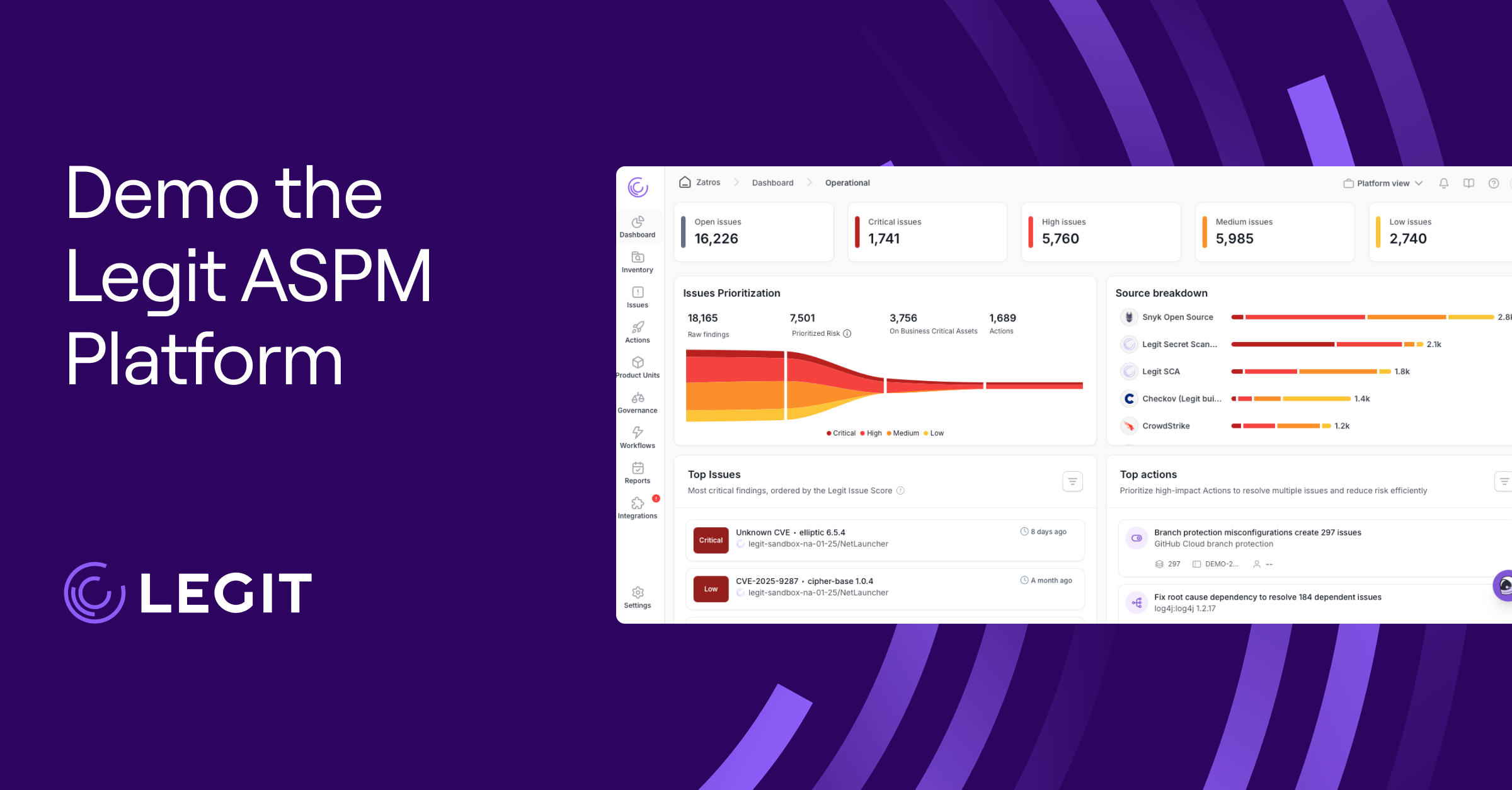Third-party integrations save time and effort during the software development lifecycle—but they also increase the risk of security breaches and make it more challenging to comply with cybersecurity regulations.
Keeping a software bill of materials (SBOM) with the right SBOM tools can help you better understand your attack surface to keep cyber attackers at bay and auditors satisfied.
SBOM Meaning: What Is SBOM?
An SBOM is a detailed inventory of all code, libraries, and dependencies used in a software application, including open-source and third-party components. It contains important facts and information about pertinent dependencies—like their names, version numbers, release dates, and licensing information.
While third-party libraries and code save developers time and effort, they could introduce vulnerabilities you don’t see until it’s too late. And with so much data and many moving parts to update in a list of materials, an SBOM is difficult to generate and track manually.
That’s where SBOM tools come in. They help identify and record vulnerabilities or important changes, like licensing updates, associated with specific components. This lets you quickly trace and address risks to keep software secure.
Integrate an SBOM tool into your existing workflows and infrastructures to:
- Find potential security risks in each component
- Track updates or changes to each component
- Monitor vulnerabilities over time
- Identify changes in licensing
- Support SBOM generation and independent source code generation
Having this information in one place facilitates smoother collaboration between stakeholders, including security teams, organization leadership, and developers. It offers a common language to discuss and a unified source of truth for the entire software inventory, making it easier to find solutions without friction between teams.
Choosing the Right SBOM Tool
Most SBOM tools have the same capabilities, but their add-ons and extra features can make or break their suitability for your organization. Here are some factors that could affect your decision:
- Integration with existing tools: Make sure your chosen SBOM generator integrates with any existing development infrastructure and processes. For instance, checking that it fits within your CI/CD pipelines improves automation and continuous security monitoring during the entire development lifecycle.
- SBOM generation independent of build environment: Select a tool that can generate SBOMs independently from your source code and/or build environment. This leads to more accurate SBOMs, even if you no longer have access to the original tools or environments used for development.
- Easy deployment: SBOM tools should make your job easier, not harder. Choose one that’s straightforward to configure and deploy, doesn’t need extensive (and specific) technical expertise, and minimally disrupts workflows. Plus, when you use an SBOM generator that supports different kinds of environments and has minimal setup time, you can start using it sooner.
- Reporting and analytics: A good SBOM tool should have reporting and analytics capabilities to offer information about the software’s composition, compliance status, and overall application security. With these insights, you can set more realistic goals to improve security. Some tools also let you create dashboards and reports customized to the interests of specific stakeholders, including security or management teams, for stronger communications.
- Thorough component identification capabilities: SBOM generators should be able to accurately identify all software components—not just internally developed code, but open-source libraries and third-party dependencies, too.
- Comprehensive features: If you’re looking for a more holistic option, consider choosing another type of tool, like an Application Security Posture Management (ASPM) solution that includes SBOM generation. We’ll recommend some below.
Top 5 stand-alone SBOM Tools
Let’s review five of the best SBOM tools on the market.
-
CycloneDX Generator
CycloneDX Generator is an SBOM generation tool that uses the CycloneDX standard, which is known for its structure and machine-readable approach. It supports multiple programming languages, like JavaScript and Python, and integrates with several development environments.
CycloneDX Generator offers automated vulnerability detection by integrating with security databases like National Vulnerability Database (NVD), Open Source Vulnerabilities (OSV), and GitHub Security Advisories to identify risks in real time. And because it’s an open source SBOM tool, it’s highly customizable and adaptable across project needs and regulatory requirements. -
Syft
Syft is an open source tool that creates SBOMs from container images and file systems. It supports multiple SBOM formats, including SPDX and CycloneDX, to create a detailed component analysis. Syft is easy to integrate into continuous integration/continuous deployment (CI/CD) pipelines for long-term security monitoring.
With automated, real-time vulnerability scanning and analytics features, Syft tracks and provides insights into an application’s components, including their versions and licenses. It also integrates with numerous vulnerability databases, including NVD, Debian Security Tracker, and Alpine Security Tracker, to promptly identify and act on security risks. -
SPDX SBOM Generator
Software Package Data Exchange (SPDX) is a standard that details software components and licensing information in a predetermined format. This promotes consistency and compatibility across different systems, regulatory compliance, and transparency—all instrumental to managing software supply chain risks effectively.
The open-source SPDX SBOM Generator tool closely tracks security vulnerabilities and compliance issues using metadata like component versioning and relationship mapping, making risk management processes and audits smoother. -
Mend
Mend (formerly WhiteSource) offers detailed component inventory, real-time vulnerability scanning, and comprehensive risk assessments. Focused on open-source security and license compliance, it automatically generates detailed SBOMs and provides updates on vulnerabilities and patches.
Because Mend incorporates effective automation tools, it integrates well with CI/CD pipelines for continuous monitoring and compliance. It also supports several regulatory standards and compliance frameworks, including the National Institute of Standards and Technology (NIST), ISO/IEC 27001, General Data Protection Regulation (GDPR), and Open Web Application Security Project (OWASP), helping you adhere to industry requirements. -
Anchore
Anchore—which operates Syft—specializes in container security, keeping software components within containers secure and compliant. Its automated scanning tools review components for vulnerabilities and compliance issues within containerized applications, generating SBOMs based on these scan results.
In addition to integrating with CI/CD pipelines, Anchore supports policy-based enforcement, meaning you can easily set and enforce security and compliance standards. Together, these features bolster security, streamline compliance efforts, and support efficient software development practices.
3 ASPM tools with SBOM features
SBOM generation is just one component of software factory protection. Opting for a holistic system—like an ASPM tool—offers stronger protection and more ease of use because everything happens in one place.
Here’s a guide to the best ASPM services out there.
-
Legit Security
Legit Security is a holistic ASPM platform that offers continuous SBOM compliance—and then some. It conducts real-time monitoring, alerts you to compliance violations, and generates automated reports outlining security posture.
Legit Security also provides real-time comprehensive vulnerability management, risk assessment, and automated remediation features that work in conjunction with SBOMs. This means you’re thoroughly vetting all components and their interactions throughout the entire development lifecycle. -
JFrog
JFrog is a supply chain-oriented DevOps solution. Its strength is software delivery, but it also offers end-to-end visibility to the entire supply chain—including high-fidelity SBOMs There’s an in-depth webinar describing the how-to of SBOM generation with JFrog for ease of use. -
Chainguard
Chainguard is a software supply chain security (SSCS) tool designed with the entire factory in mind. It provides real-time updates on component security and integrates with CI/CD pipelines for continuous monitoring. On top of these features, Chainguard’s reporting and analytics tools make it easier to closely track supply chain security and create SBOMs for Chainguard Images.
Create SBOMs as Part of Your ASPM With Legit Security
The only tool more helpful than an SBOM generator is one that does more. Legit Security’s ASPM services automatically track every software component, identify vulnerabilities, and stop your team from constantly playing catch-up with risks.
Feel confident that you and your customers experience the safest software possible. Request a demo to learn more about how Legit Security can help you make the most out of your SBOM today.
Download our new whitepaper.


